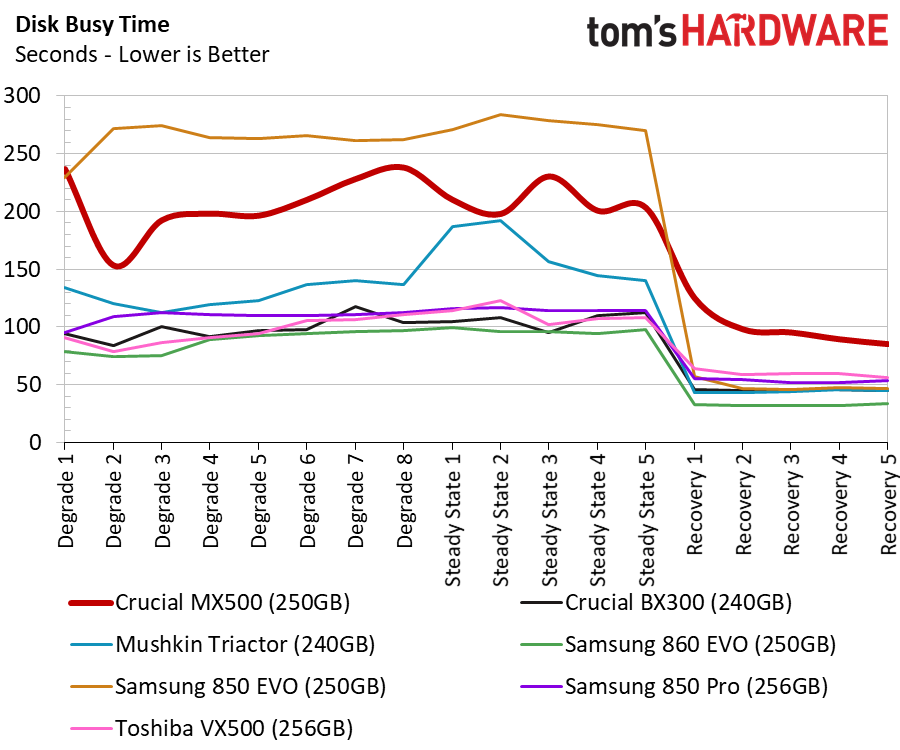Crucial MX500 SSD Review: Challenging Samsung on SATA
Why you can trust Tom's Hardware
Comparison Products
The 256GB- and 128GB-class SSDs are still very popular globally, but I don't think they are popular with our readers. Many of us abandoned 128GB SSDs because they often cost more per gigabyte than 256GB SSDs. The introduction of 64-layer NAND from Toshiba and Micron makes small SSDs great again, but low-cost 512GB SSDs like the new 500GB MX500 ($139.99) are still more attractive.
We included the Crucial BX300 with Micron's first-generation 3D MLC flash. The Mushkin Triactor and Toshiba VX500 represent 2017-era SSDs with planar TLC flash. We also included three Samsung SSDs with V-NAND flash.
Sequential Read Performance
To read about our storage tests in-depth, please check out How We Test HDDs And SSDs. We cover four-corner testing on page six of our How We Test guide.


We still see similar sequential read performance even with a wider range of drives. The drives all push against the upper limits of the SATA interface, but that ceiling comes at a different queue depth for each product. At QD2, the 250GB MX500 trails the Samsung 850 Pro by only 11 MB/s.
Sequential Write Performance


The burst tests no longer show the wild waves for every product due to the micro-sized SLC cache. The write cache on the Mushkin Triactor is so much smaller, though, that we can't build a reasonable sequential test without producing an inconsistent result. We're not picking on the Triactor, though. For several years numerous products came to market with planar TLC flash because they served as the low-cost alternative to MLC SSDs.
Crucial chose to bring a better low-cost SSD to market, and that's the brilliance of the MX500. The 250GB performs much better than the low-cost previous-gen SSDs, even in the smaller capacities.
Sustained Sequential Write Performance
The sustained sequential write speed drops to 200MB/s after the SLC buffer is full. This is half the speed of the 1TB MX500. The SSD adjusts the cache capacity dynamically based on the amount of data stored on the drive. An empty drive has roughly 46GB of high-speed cache that absorbs data at 450 MB/s.
Get Tom's Hardware's best news and in-depth reviews, straight to your inbox.
Random Read Performance



The 250GB MX500 follows the high random read trend with a massive 12,000 IOPS at QD1. This is faster than we expected to see in this capacity, which is a pleasant surprise. The 250GB MX500 also scales very well as we increase the queue depth.
Random Write Performance



Most of the newer drives all score well during the random write tests. This is largely a test to look for issues that may impact mixed workload performance during real-world workloads.
70% Mixed Sequential Workload
We describe our mixed workload testing in detail here and describe our steady state tests here.


The MX500 250GB falls to the middle, but it is very close to the leading drives at low queue depths.
70% Mixed Random Workload

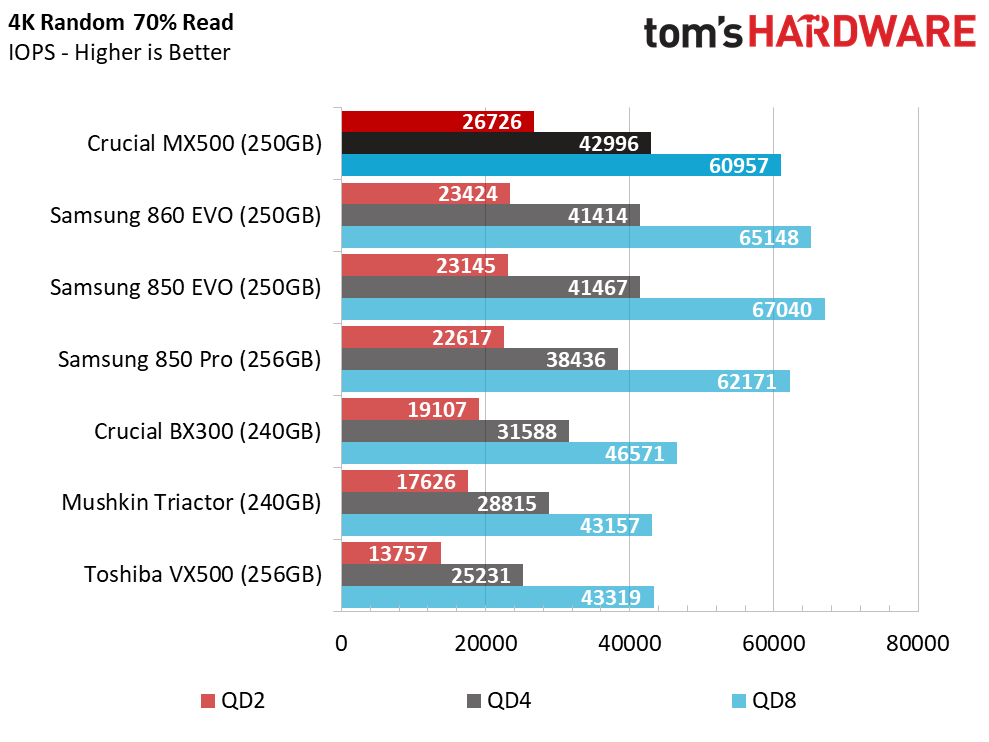
This test repeats a now-familiar theme: the MX500 series delivers exceptional mixed random performance. During the design phase, Crucial focused on the cache system to increase system responsiveness and reduce cost.
Sequential Steady-State

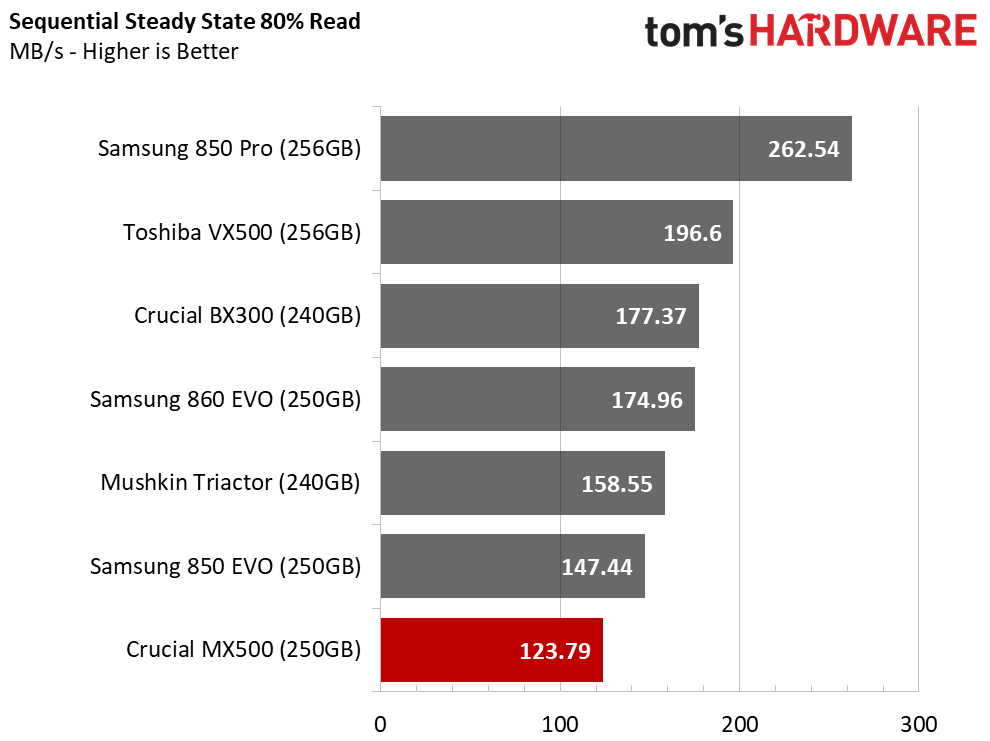

The high-capacity MX500 SSDs perform much better than the 250GB model. Most of these drives will never see a workstation outside of a DIY system with a RAID array. NVMe has taken over this market, but it's still fun to see how the smaller drives perform under these conditions.
Random Steady-State
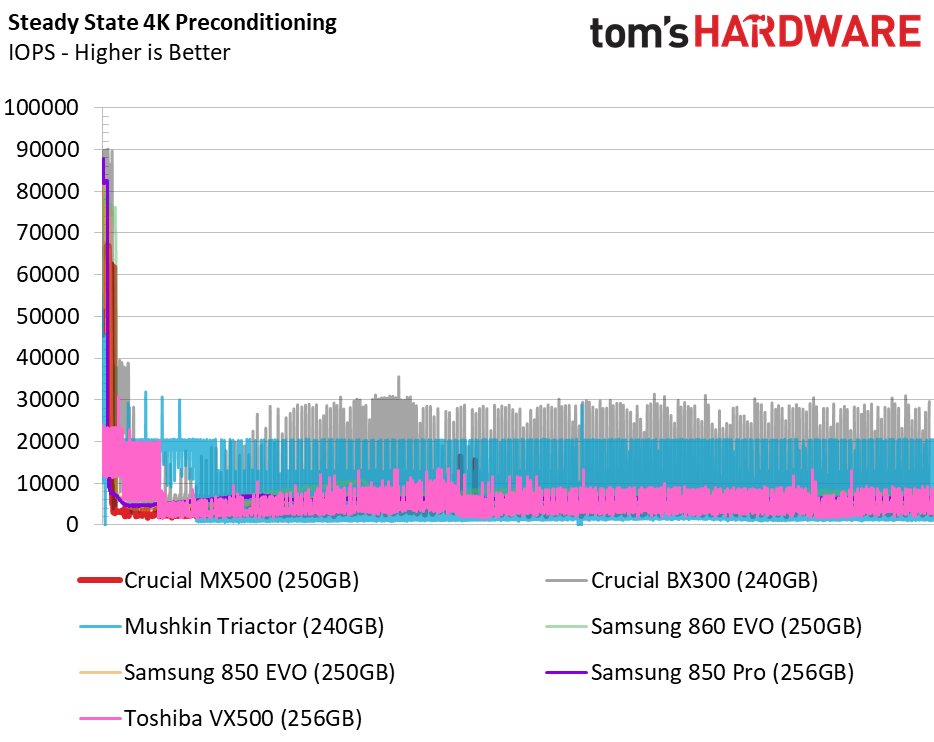
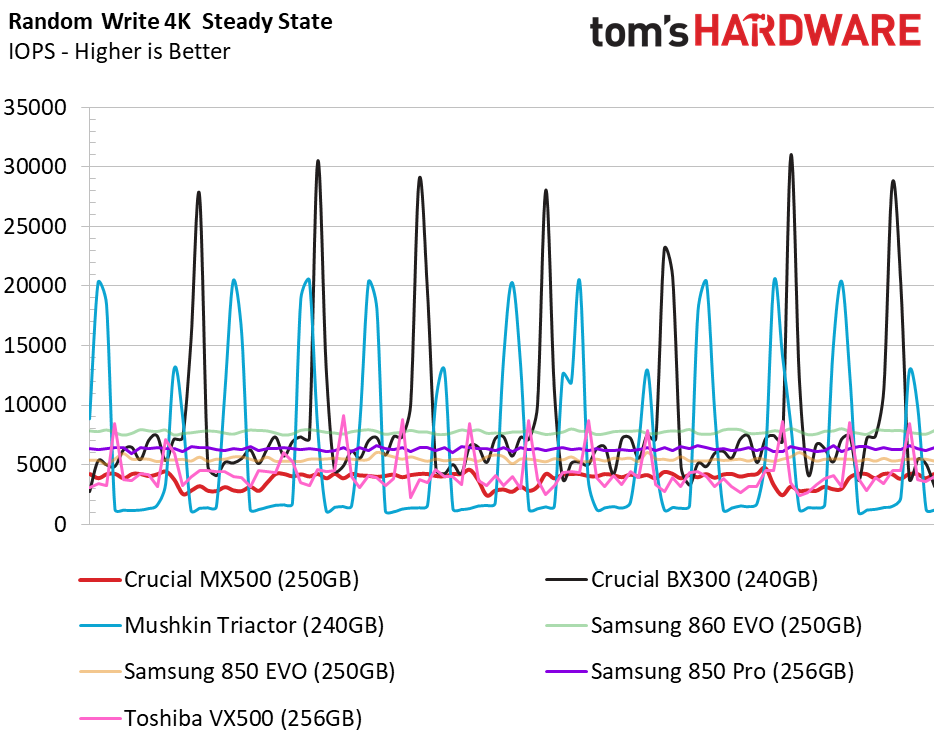

The 250GB MX500 doesn't have the same high peaks as the other drives in the random workload test, which measures worst-case performance in steady-state conditions. Luckily, most users will never put these drives through this kind of abuse.
PCMark 8 Real-World Software Performance
For details on our real-world software performance testing, please click here.


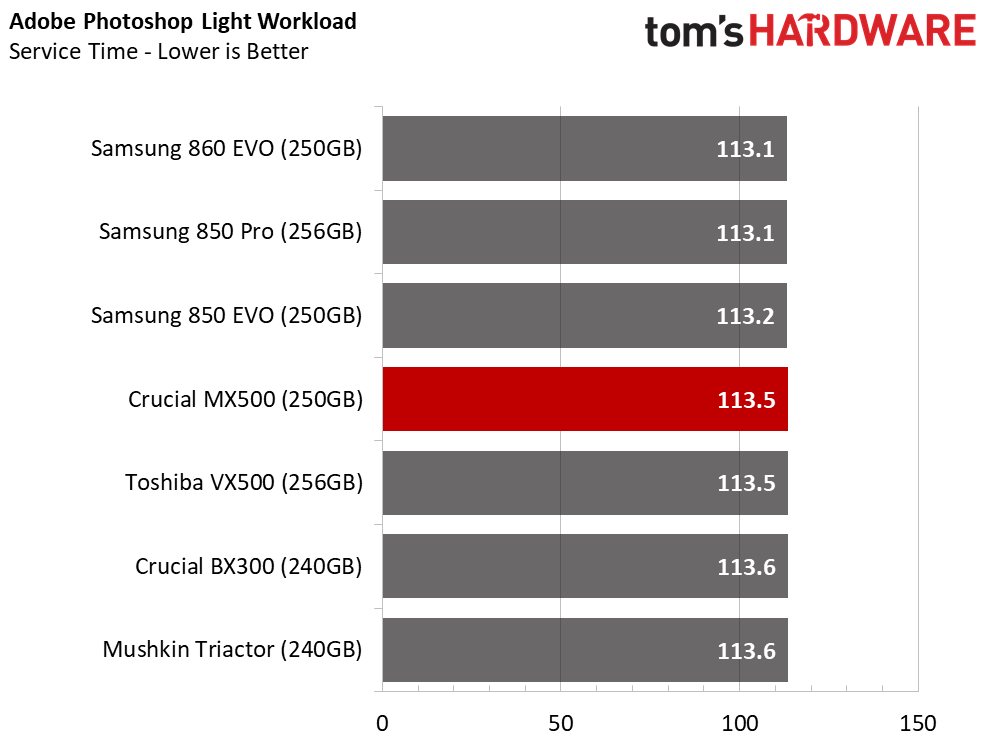



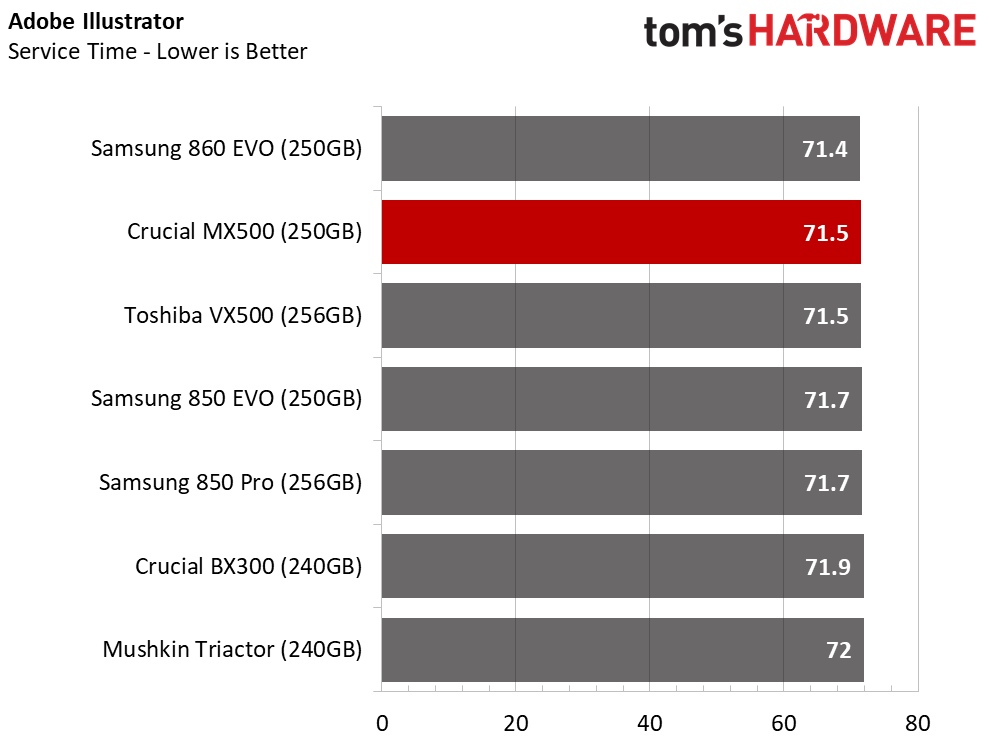



The 250GB MX500 provides acceptable performance in application tests. Modern SATA SSDs are all so similar that performance is less of a concern, especially if you remove the planar TLC flash and DRAM-less models.
Application Storage Bandwidth
The 250GB Samsung 860 EVO ($95) is the only real standout in our application tests. The latest 250GB EVO costs $15 more than the MX500, which only trails by 24 MB/s in an hour-long test. It's not a significant difference, but the results fall in line with our expectations.
PCMark 8 Advanced Workload Performance
To learn how we test advanced workload performance, please click here.



The 250GB MX500 struggles after a heavy workload. The slow recovery has been an issue with this series, but the 250GB model is the first that worries us. This model is not competitive with its peers in the bandwidth test, but it gets worse.
Total Service Time

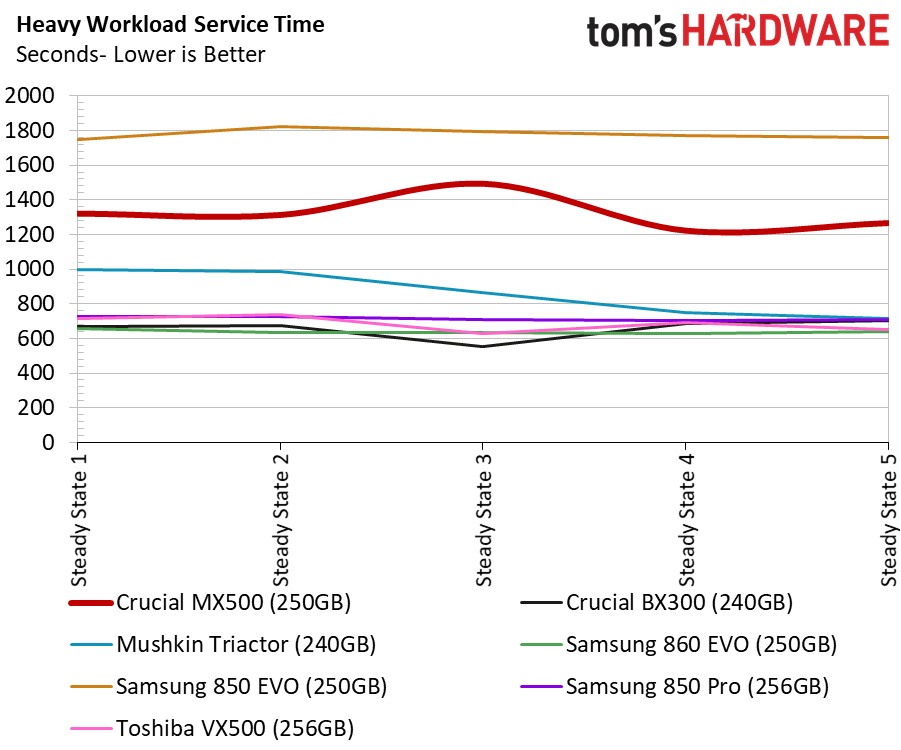

The 250GB MX500 suffers from high latency as it exits the heavy workload. In this capacity, I would spend the extra $15 for the 860 EVO because I install a lot of data rapidly when I first configure a system. Over time, the MX500 will recover and deliver a better user experience, but you should never have to go through a period of degraded performance with a modern SSD.
Disk Busy Time
The disk busy time test shows us that the 250GB MX500 works much longer than many of the other drives.
BAPCo SYSmark 2014 SE Responsiveness Test


We're still trying to figure out why the MX500 doesn't perform as well in the responsiveness test as the synthetic numbers lead us to believe. We theorize that the dynamic cache shrinks after we install the operating system and all of the software. It doesn't render the cache ineffective, but it does take a bite out of the extra performance.
BAPCo MobileMark 2012.5 Notebook Battery Life
To learn how we test advanced workload performance, please click here.
The 250GB MX500 delivers average performance in our notebook battery life test. We run the test on a Lenovo Y700-17 gaming system, so it's not as efficient as a business model designed for extended time away from a wall outlet. This is the same level of performance we often see with the OEM storage solutions that ship in notebooks.
MORE: Best SSDs
MORE: How We Test HDDs And SSDs
MORE: All SSD Content
Current page: 256GB Performance Results
Prev Page 512GB Performance Results Next Page Final Analysis
Chris Ramseyer was a senior contributing editor for Tom's Hardware. He tested and reviewed consumer storage.
-
HERETIC-1 Hi Chris,Reply
That 4K read at QD1 is impressive.
Am holding my praise until I see the 250 size tho........... -
unityole 2TB for $520? not bad at all for a TLC drive, especially one at this performance level considered to be better than the best in industry. nice review Chris! can't wait for a 4TB of this drive out for less than $800 though.Reply -
bit_user Reply
Glad to see this. The MX300 was such a let down, performance-wise, and I'm eager to see prices drop in the 1 TB size.20498199 said:...
Do they still advertise end-to-end data protection? The Crucial MX-line has tended to be one of the more reliable options, and I hope that doesn't change. It's one of the main reasons I've never been tempted by Samsung. I have 9 Crucial SSDs and no failures (yet).
Did they ever explain what happened to the MX400? Maybe a product that got cancelled?
Also, I wonder how much DRAM it's got. -
bit_user Reply
Truly. I always figured Samsung has got to be close to what SATA can deliver. I didn't expect anyone to provide such an improvement, much less for Crucial to take the lead.20498288 said:That 4K read at QD1 is impressive.
-
bit_user Partially answered my question about data protection. They don't advertise "end-to-end data protection", as before, but I recognize a number of features carried over from the MX200:Reply
• Redundant Array of Independent NAND (RAIN)
• Exclusive Data Defense
• Error Correction Code (ECC)
Of course, all SSDs have some sort of ECC. However, the MX200 advertised what they call "Data Path Protection", while the MX500 lists "Multistep Data Integrity Algorithm". So, I'm still wondering if these are comparable.
Here are the datasheets I could find:
http://www.crucial.com/wcsstore/CrucialSAS/pdf/product-flyer/crucial-mx200-ssd-product-flyer-letter-en.pdf
http://www.crucial.com/wcsstore/CrucialSAS/pdf/product-flyer/crucial-mx500-ssd-productflyer-en.pdf -
TripleHeinz Similar to bit_user, I have crucial/micron for all my memory needs: From storage to RAM. I went with this brand 4 years ago and their products have never let me down. The reason I went with crucial/micron is because at the time of purchasing they were the only brand offering enterprise class solutions for workstations where data integrity, privacy and safe storage are critical. Their products had all kind of ecc and data integrity technologies, encryption of all kinds (providing whitepapers to teach how to implement them) and power loss safety through super caps which allow data to flush from cache even on power loss (you can safely disable "write-caching buffer flushing" in Windows for better performance). You can install Storage Executive for monitoring but you should not enable "momentum cache" because if I'm not mistaken you could lose your data on power outage.Reply
I understand that now Samsung has most of these features in their products, but I can't simply go away from a brand that I trust and have been working with their products for years now with success. The SSDs have been working perfectly, they feel pretty fast too, I love them. They still report 100% life, can't explain that. I'm a satisfied customer and can recommend crucial/micron for workstations. -
bit_user Reply
Yeah, I don't bother with it. The OS should do write buffering, and I see Momentum Cache as basically a Band-Aid over Windows' deficiencies.20499336 said:You can install Storage Executive for monitoring but you should not enable "momentum cache" because if I'm not mistaken you could lose your data on power outage.
But the biggest worry I have about system crashes is actually filesystem corruption, and there Momentum Cache has a lot more potential to harm than help.
Anyway, use a UPS to mitigate against power loss. Now that PCs and monitors are so power-efficient, you can get by with a much cheaper unit than before. I have a nice PFC-compatible CyberPower that was < $100, IIRC.
Really? I've not seen that, and I had been checking until fairly recently.20499336 said:I understand that now Samsung has most of these features in their products,
Also, note that Crucial's BX line lacks many of the reliability features found in the MX line.
The main thing for me is the user reviews. At least up through MX200, Crucial was rated highest. I didn't bother checking MX300, however.20499336 said:I can't simply go away from a brand that I trust and have been working with their products for years now with success.
A co-worker recently mentioned two Crucial SSD drive failures among his family members. He didn't say which model, but I wonder if they were BX drives. -
JimmiG "CONSReply
The look appears dated"
Yeah, not a single RGB LED. Unacceptable.
Seriously though it's good to see the race to the bottom in consumer SATA SSD's seems to have reached an end. This drive from 2017 even manages to beat the 2014 Samsung 850 Evo in a few tests. -
CRamseyer You have to remember that we see every Crucial drive and the packaging hasn't changed much over the years.Reply
I also had to think of something to fill in the space. That's the only part about the drive that I would improve if I was the product manager....and make a 4TB version.





